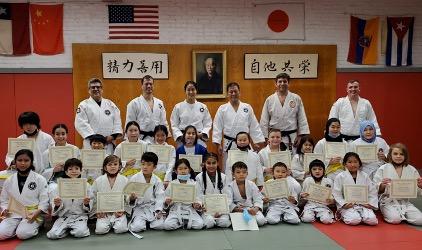On Saturday, January 29th, promotion test at the Tohkon Judo Academy took place. I participated as a judge.
I believe you all know “black belt” but I would like to explain a bit about the road to black which includes the grades and the promotion test.
What is a promotion test?
In Japan, the Grades and the color of belts are defined as the chart on the left. Grade School children can only achieve up to 2nd Grade (Purple Belt), and you must be 14 years old to earn a black belt (In the US it’s 15) Having age restrictions is the same in the US and Japan, however, in the dojos in Japan, promotion tests are not frequently done and moreso the Grades are classified by their age, or in most cases the teachers observe and decide in which as a result, the first test that people take is the Black Belt Test.
In the US, on the other hand, categorizes Grades into more detail, where all kids have an objective which then enhances their motivation.
2 tests take place each year (one individual can only apply once a year) and if you pass, you get a Grade promotion where the color of your belt changes. This is a big event for the kids. I would like to introduce the contents of the test together with the reaction of kids and myself.
There are no uniform rule for the color of belts for each grade, but Kodokan has stipulates as follows.
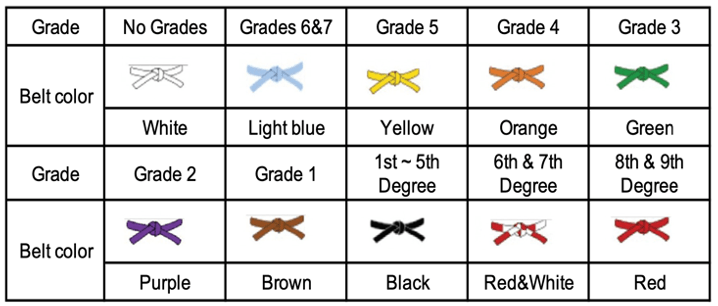
(1) Everyone likes the challenge!! (We had 22 applicants)
Although it is held within the club (Dojo) the total count was 22 just with kids!!
Every year tests are held in January and July – if you take a test 6 months ago, you are not eligible to take the test again.
So as a result, it’s a once a year event. It is a very precious opportunity for kids, and its crunch time!!
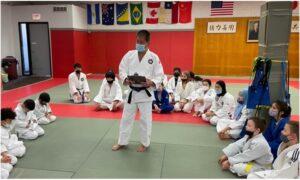
Explanation by Sensei Doug Tono. Everyone is serious.
(2) Contents are as bold as a Black Belt Test!!
Judokas would know, but a Black Belt test includes physical and written test where you need to know the history of Judo.
Here, 7 or 8 year old kids need to know this together with Judo lingo. AND, more than half of the contents are in JAPANESE!!
Here’s an excerpt of the test. It should be tough for the kids in US to understand Japanese. Please try it for yourself.
(3) However, American Kids are natural and strong
It’s a test and it’s a once a year big event expecting these kids to be nervous. Nope, dojo as usual. Kids run around the dojo before practice. Maybe the parents and myself are more nervous than they are. These kids are powerful yet natural.
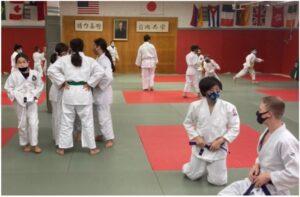
The kids are relaxed and running around, even if it’s right before a test!!
*Below are the excerpts from the test
Test Contents (7th Grade)
Test for Yellow Belt (7th Grade) Kids (Mainly 8~10 years old)
Test 1:Technique Demonstration (in pairs)
- 5 types of Standing Techniques (Hip Wheel/Major Outer Reap /One Arm Shoulder Throw/Major Hip Throw/Major Inner Reap)
- 6 types of Hold Down Techniques (Scarf Hold/Rear Scarf Hold/Modified Scarf Hold/Shoulder Hold/Top Four Corner Hold/Modified Side Lock Hold)
- 2 types of Turnovers (Opponent in Kneeling Position)
- 2 types of Turnovers (Opponent on Stomach)
- Escape from Kesa Gatame (Scarf Hold)
- Escape from Kami Shiho Gatame (Top Four Corner Hold)
Test 2:Verbal Q&A (Questions about JUDO)
Everyone gets 8 to 10 questions asked – all are different.
- The difference between Judo and Jujistu?
- Who founded Judo, what year?
- What does Kuzushi/Tsukuri/Kake mean?
- What does Shime/Osaekomi/Katame/Te/Koshi/Ashi/Kansetsu Waza mean?
- How many ways to win Judo match?
- Demonstrate Ippon/Waza Ari/Matte hand signal
- What does SENSEI/REI/SEIZA mean?
The image below is the list of translated WAZA into English – it’s hard for me to learn the translated version, but a good English practice for me.
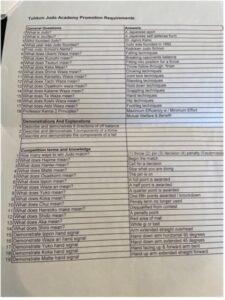
Part of the test. For me, it’s an English textbook.
This test would be even tough for Judo Kids in Japan.. JUDO is taught in Japanese so learning the sport and language… I admire these kids as well as all the JUDOKAs around the world.
Kids are not scared to make mistakes – even during the test they’d ask me (who’s judge!!) “Was it like this???” They’re in their own world.
Nonetheless, everyone passed the test and left the DOJO with a big smile.
With no relation to a result of a match, no relation to who’s strong or not – the promotion test provides equal opportunity for everyone. By having a clear objective, this keeps the motivation in kids which makes this test a very special event.
Watching the kids in their “everyday” mode, I felt that it wasn’t Judo, but being with your buddies was the factor that made them happy. I need to create more and more opportunities like this – which would be the vision of GJKN.
Everybody great job & congratulations~~!!!



